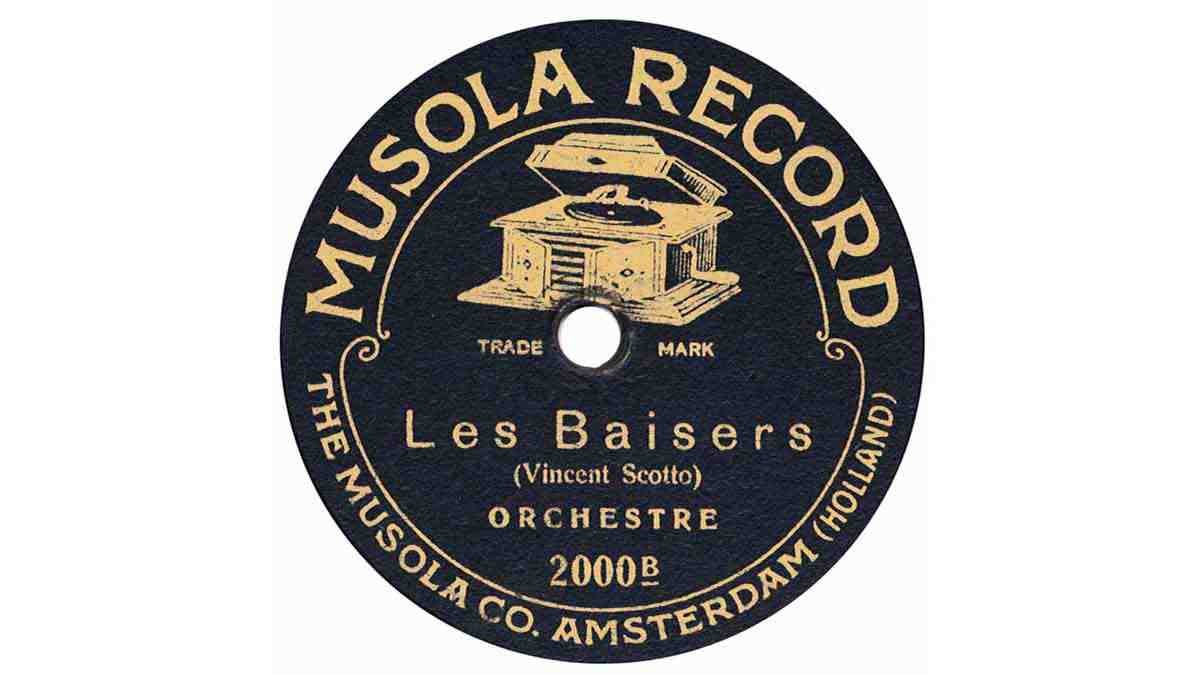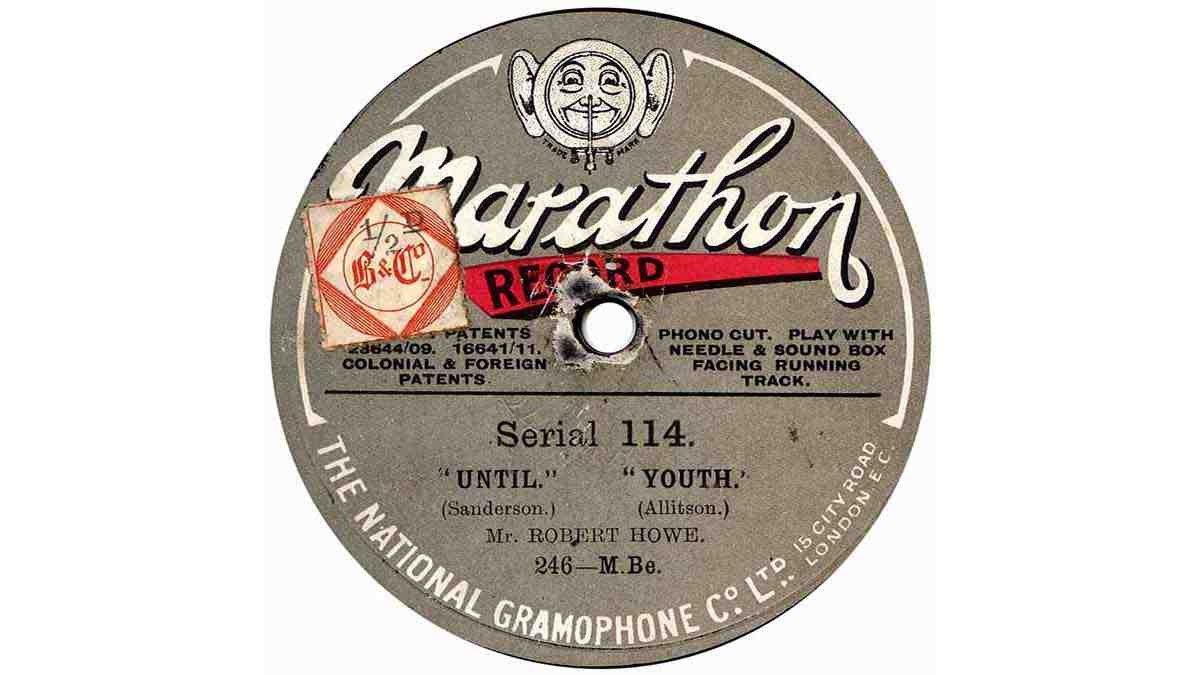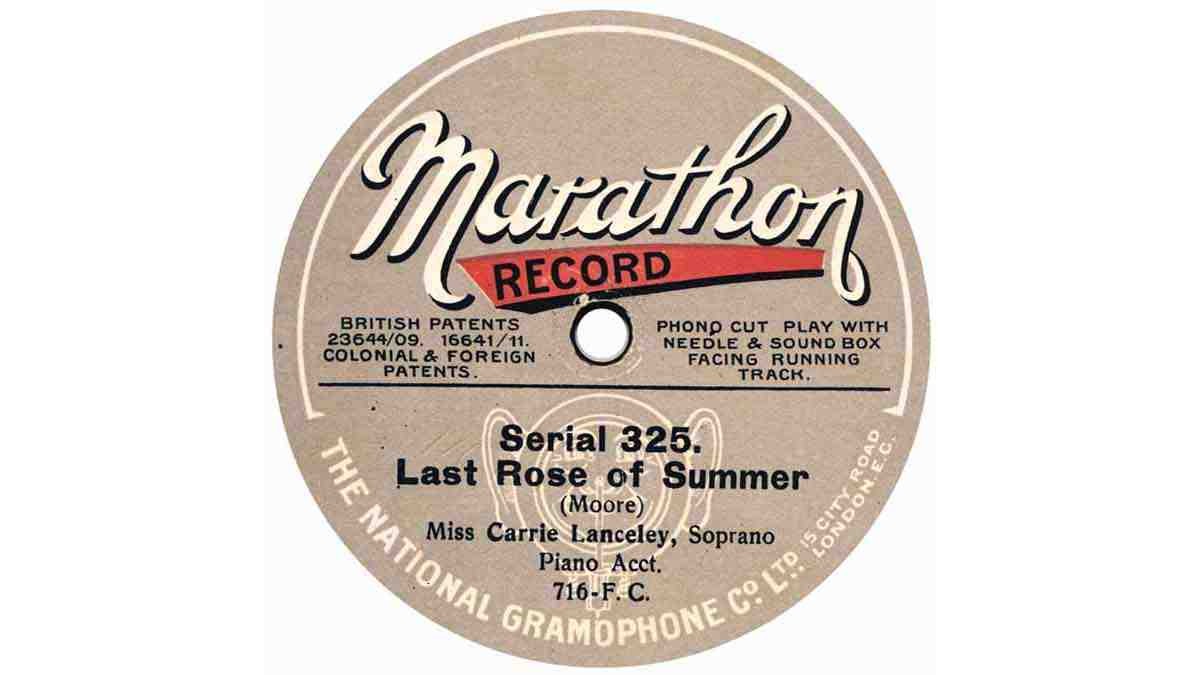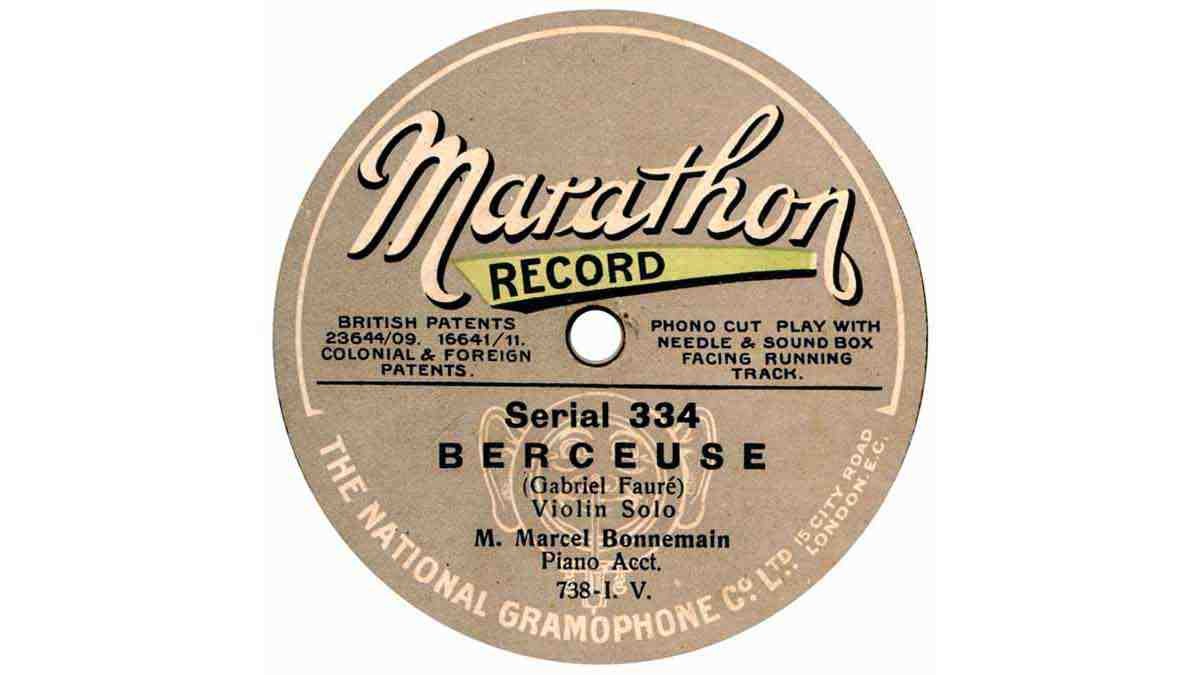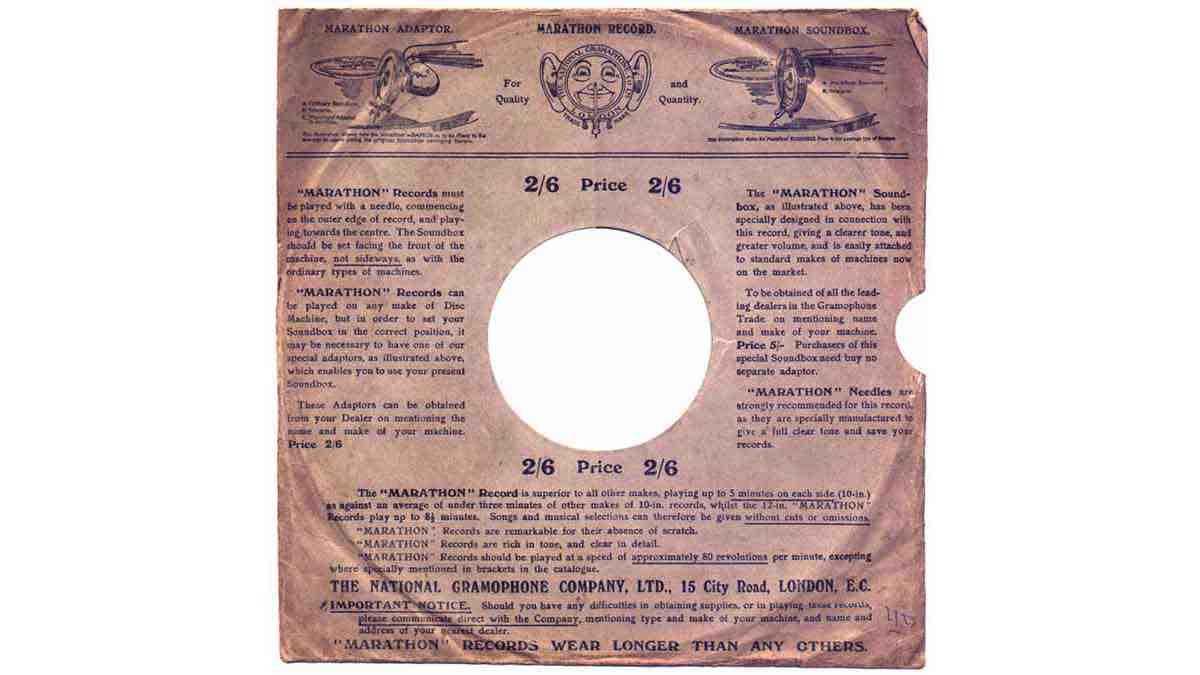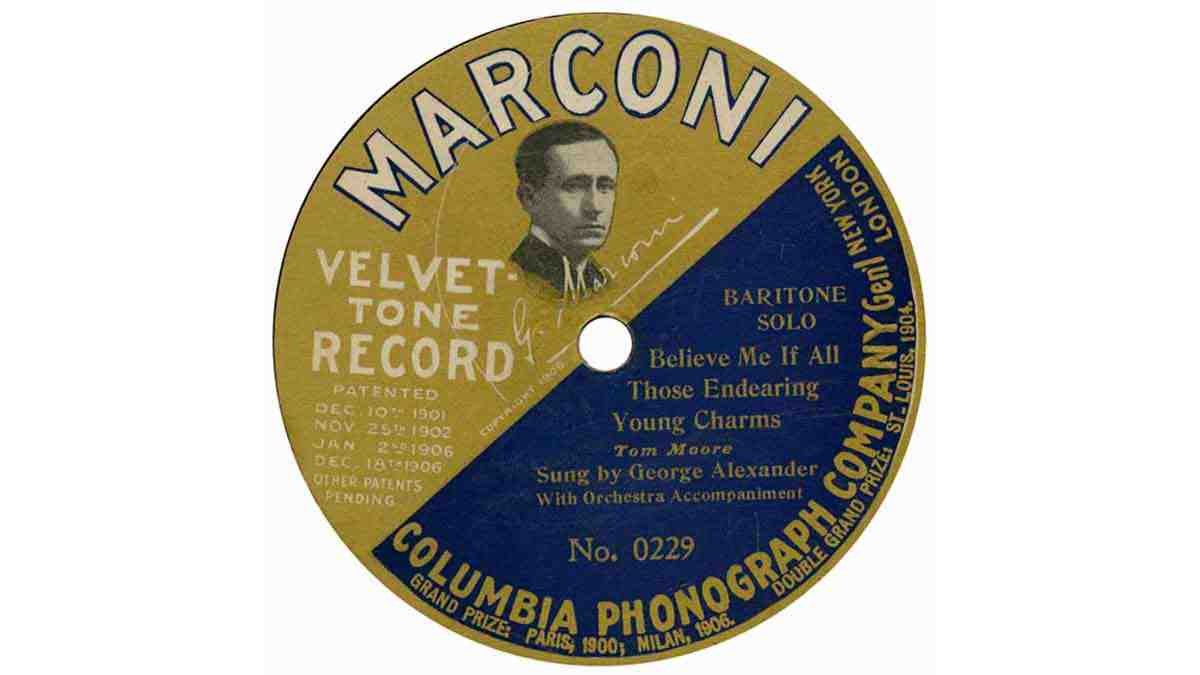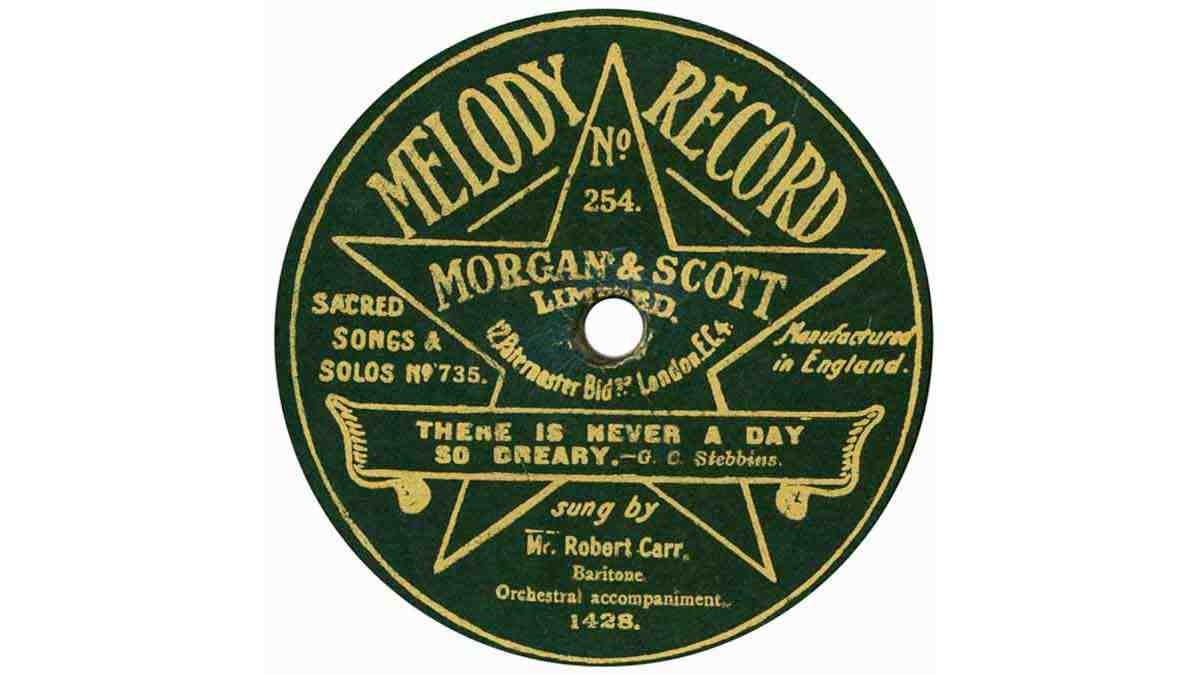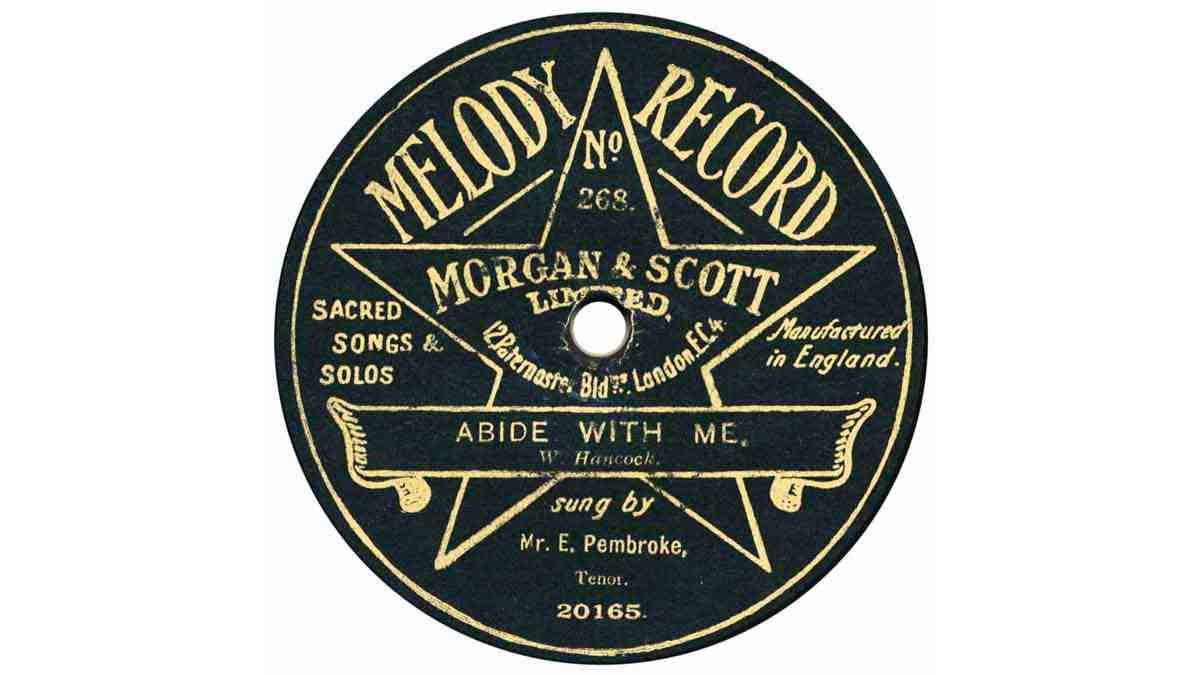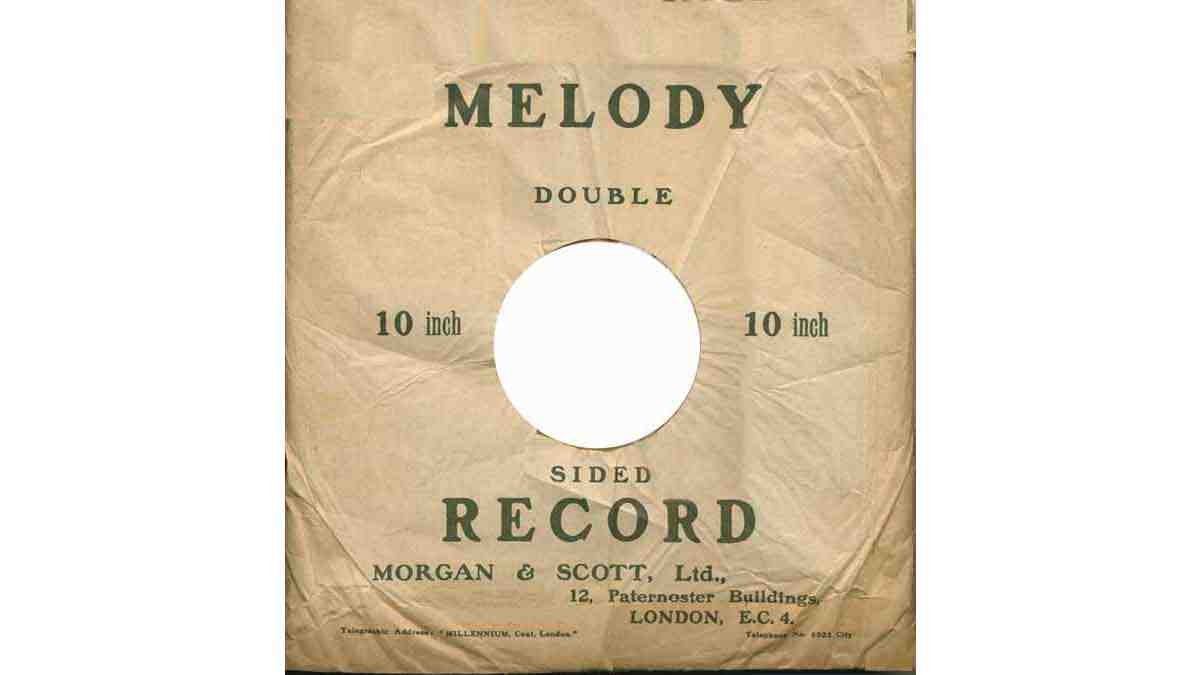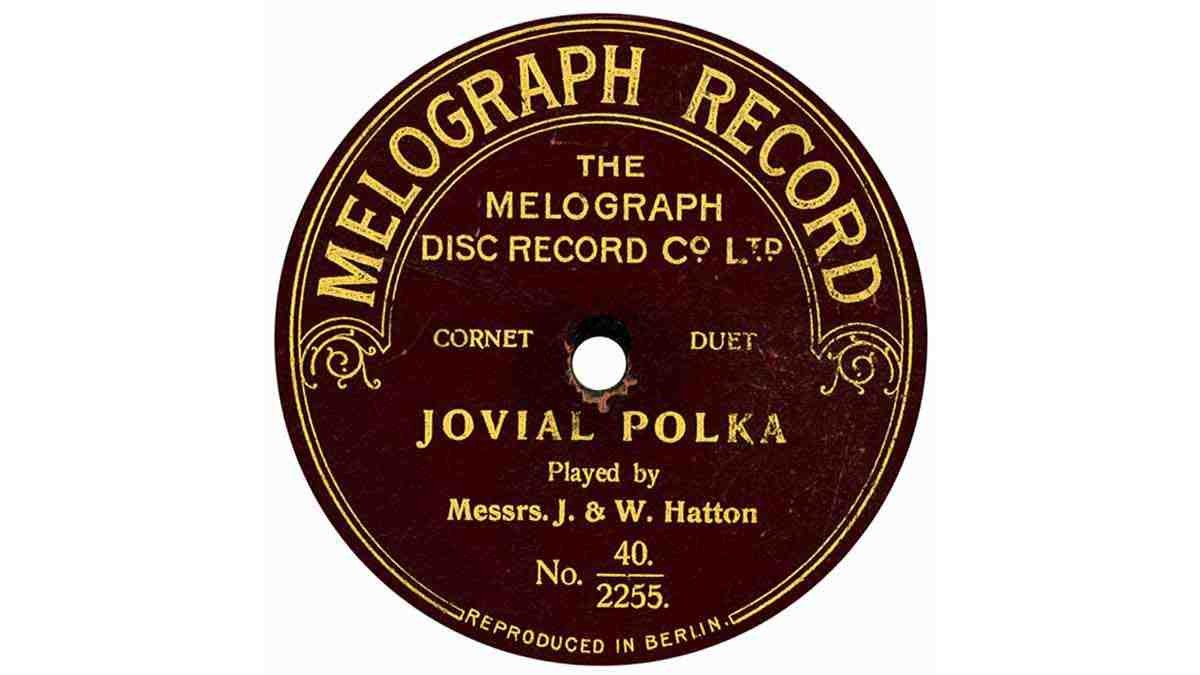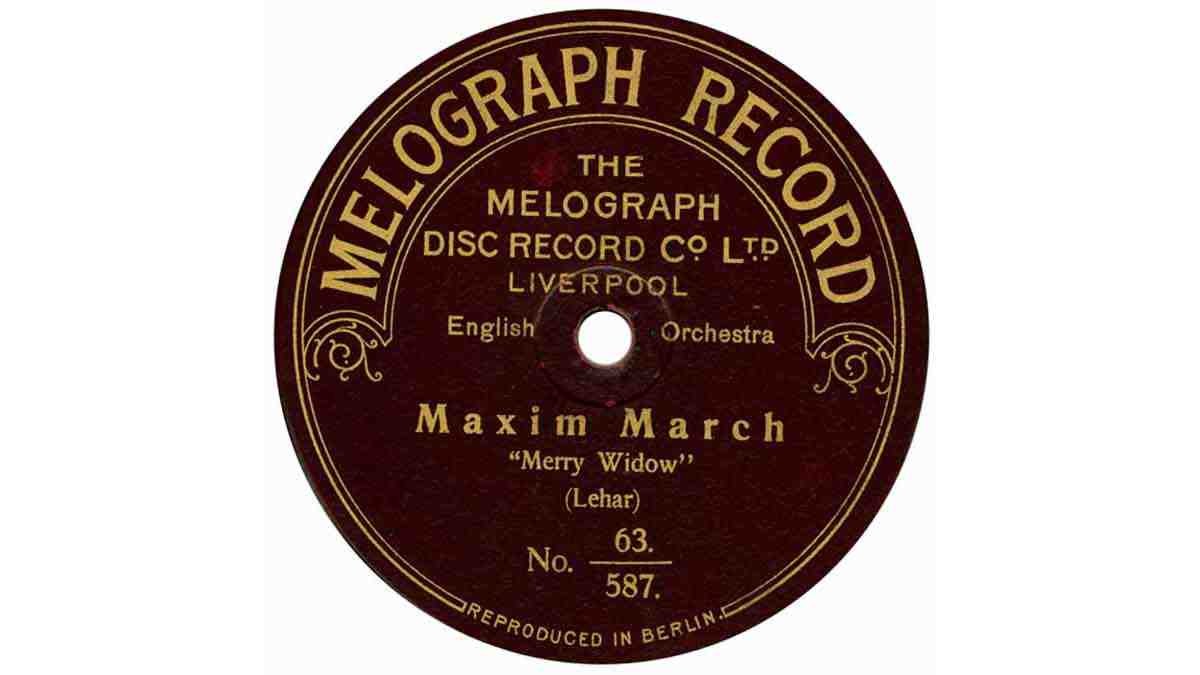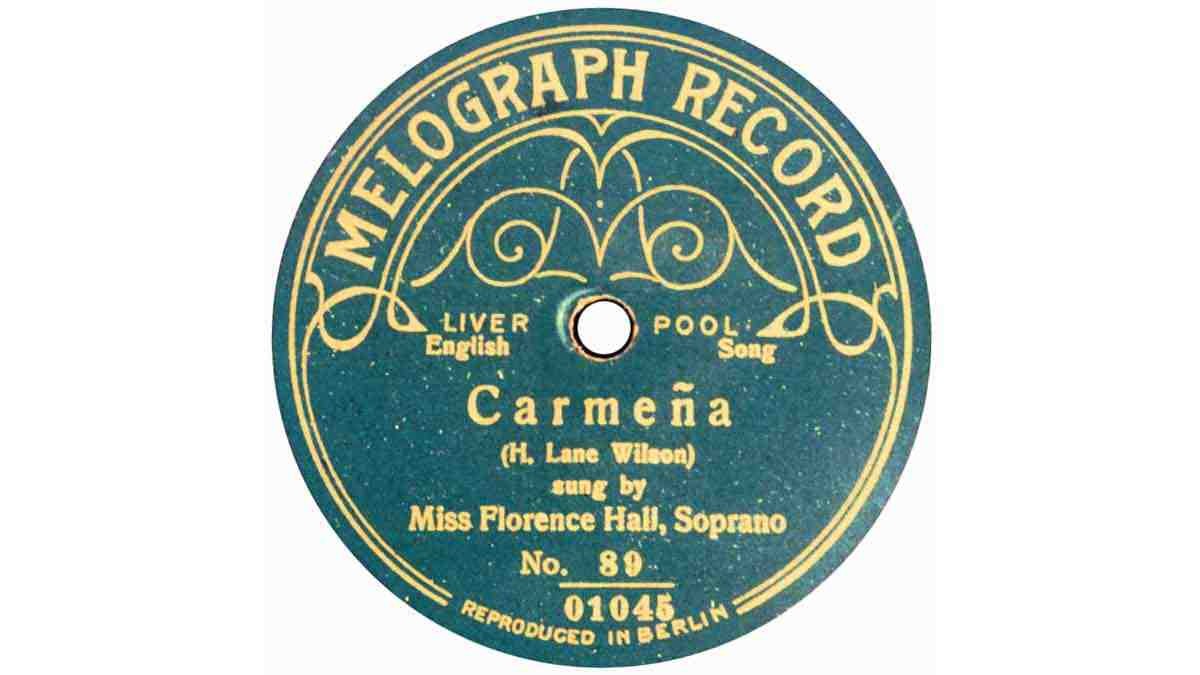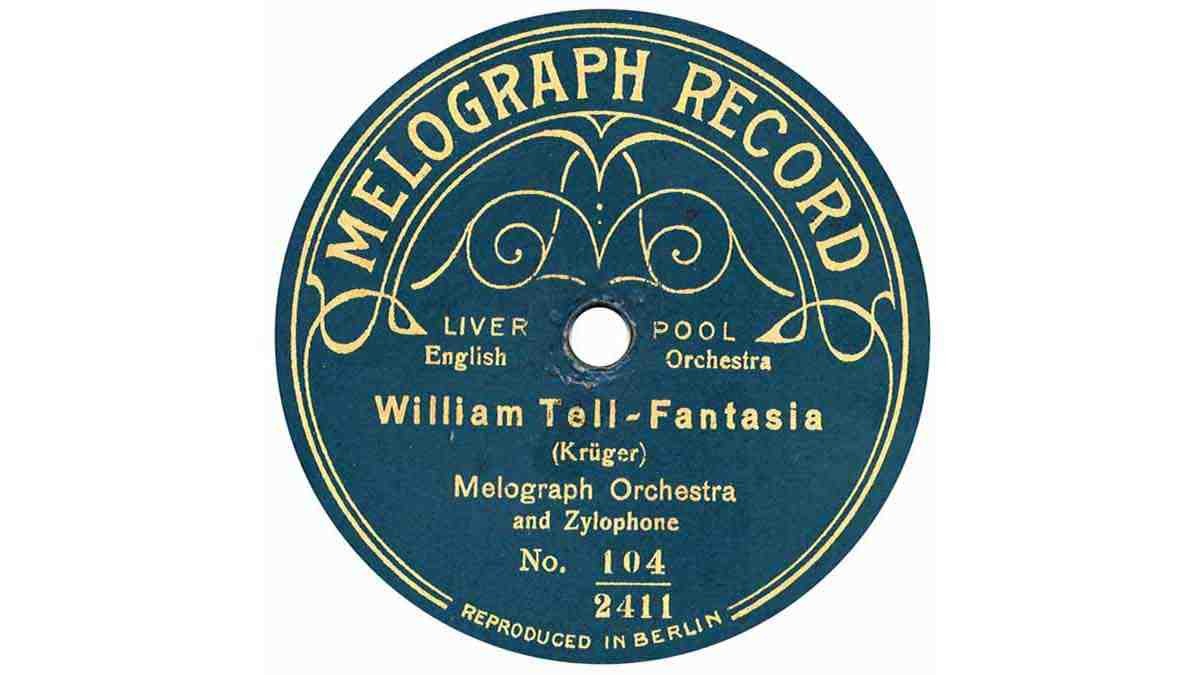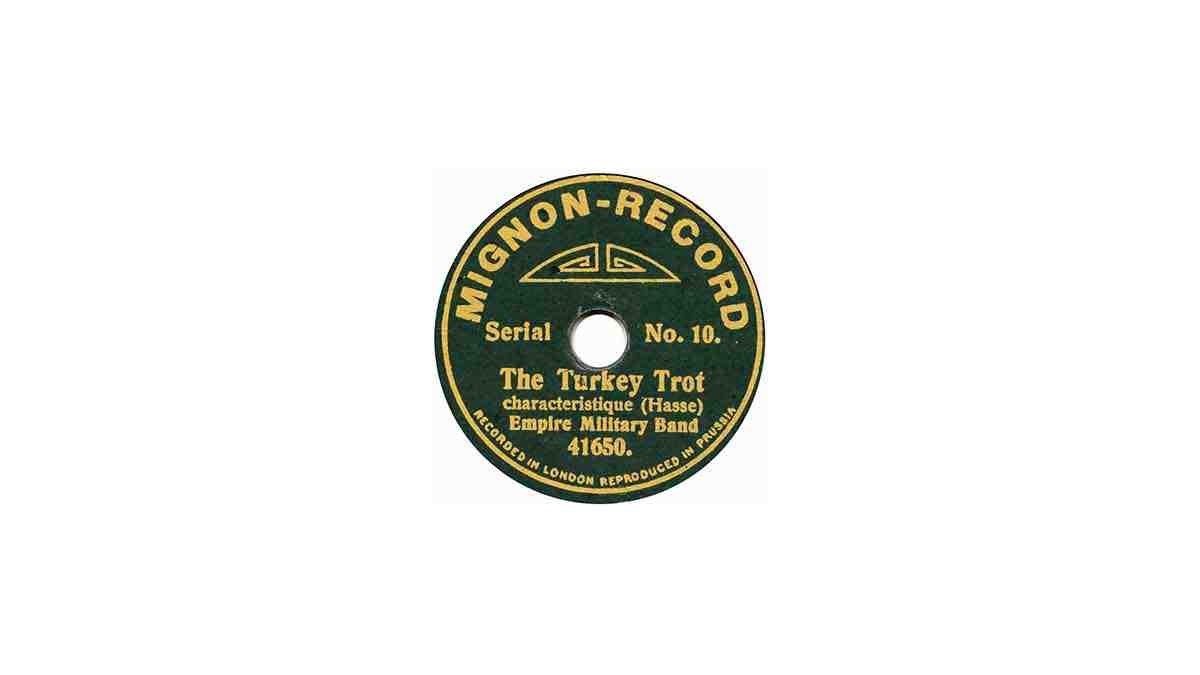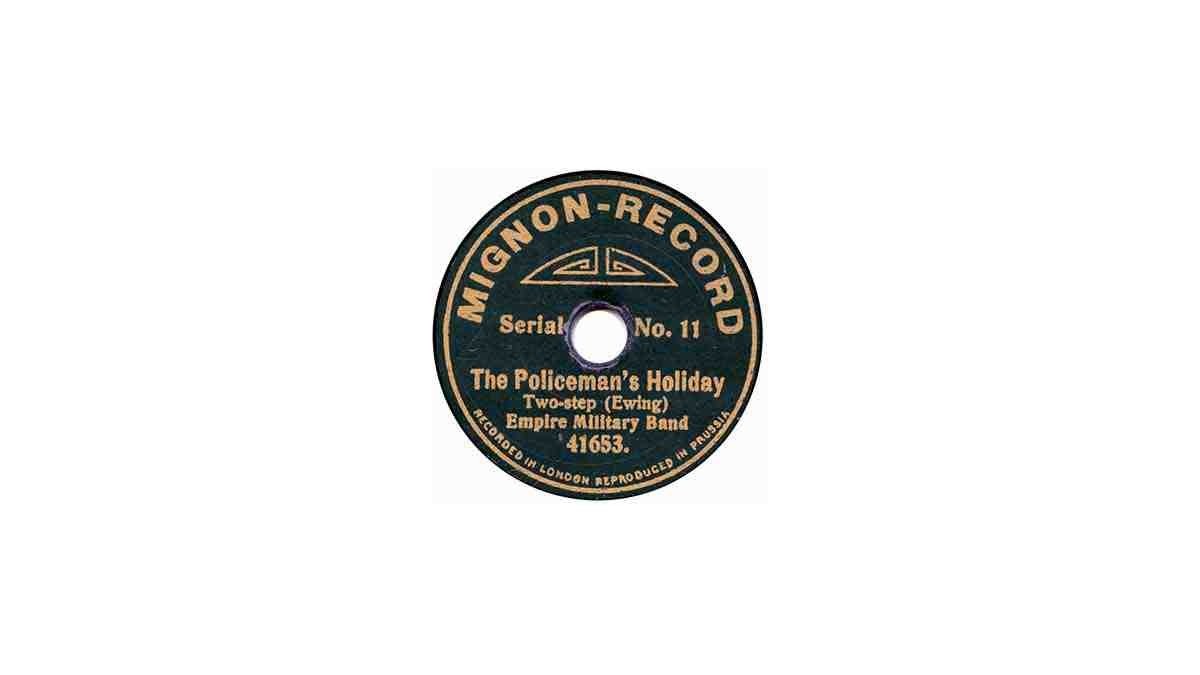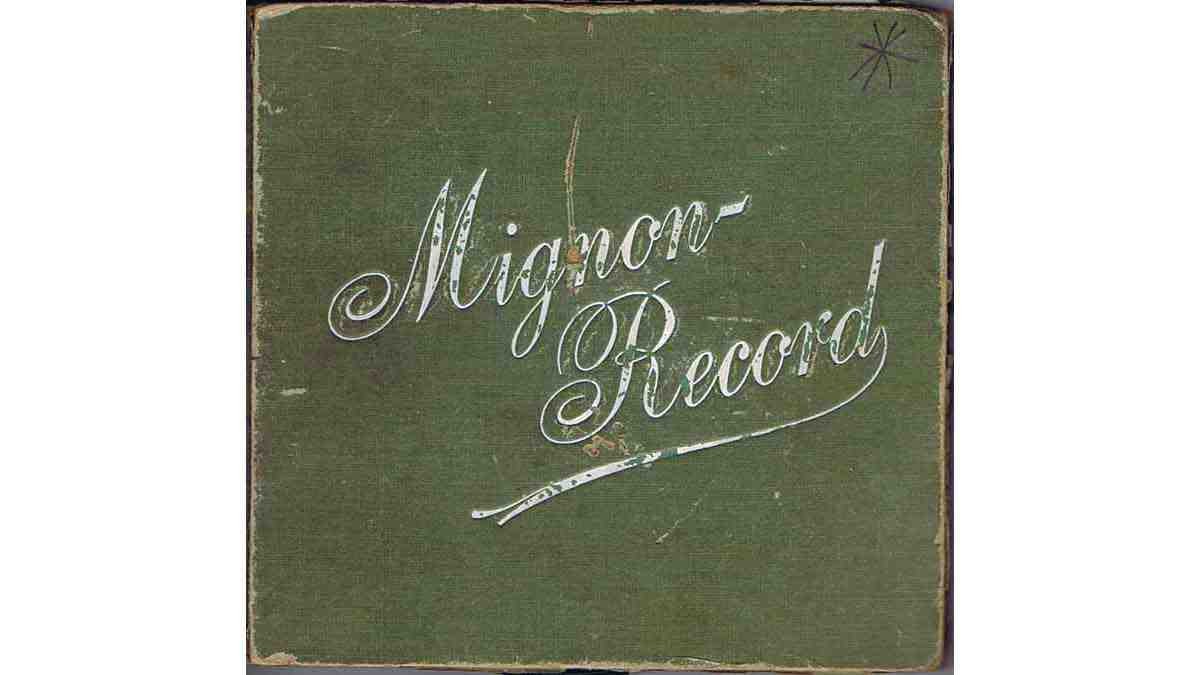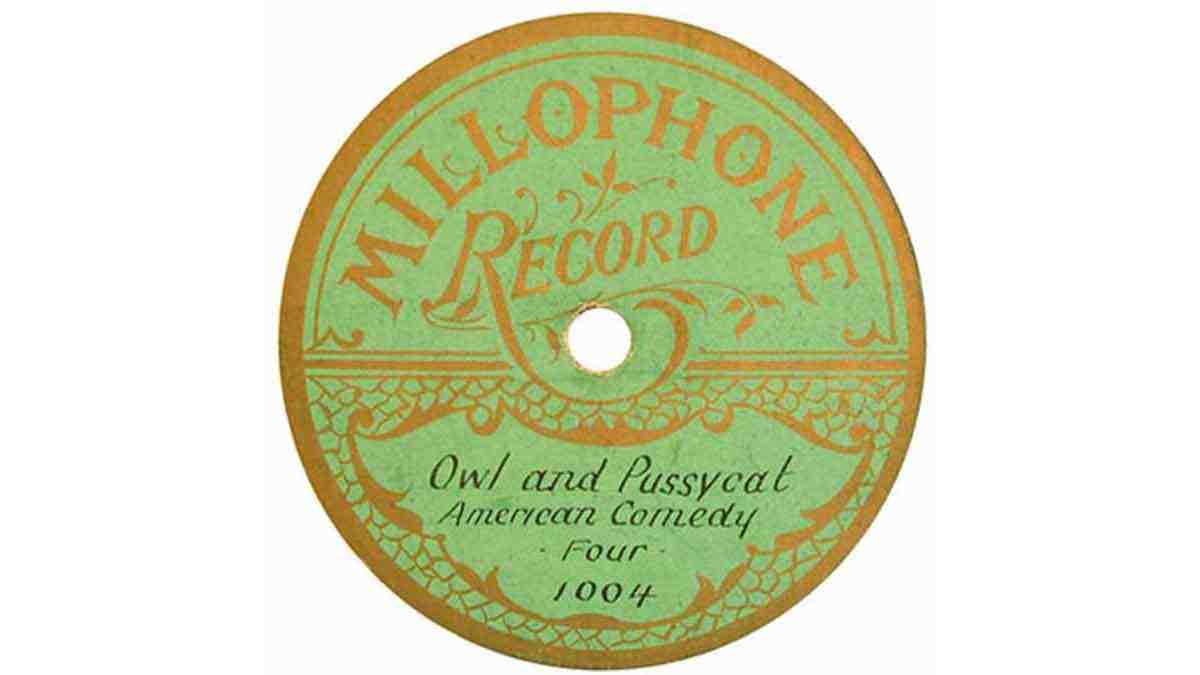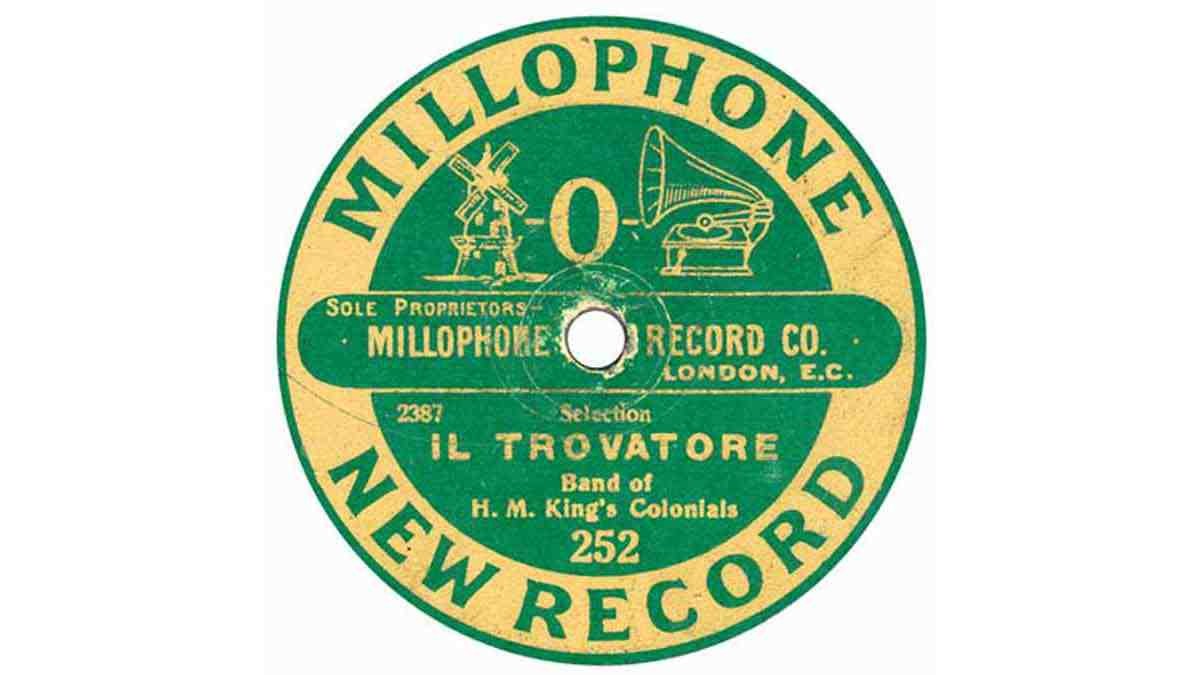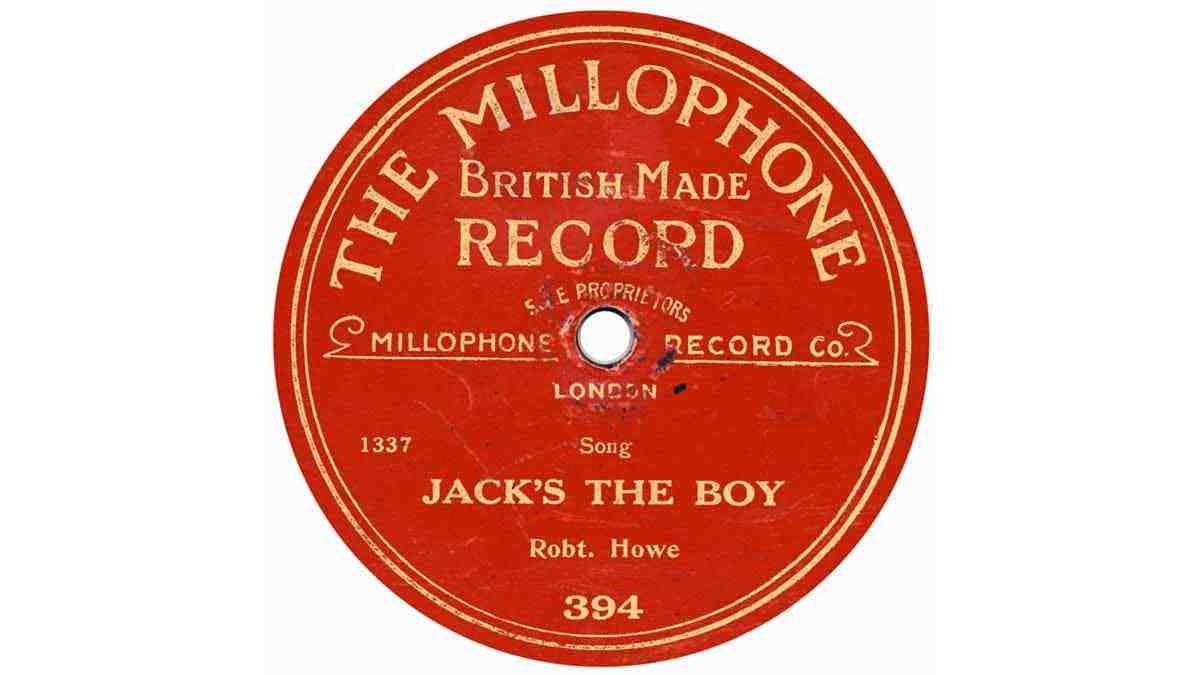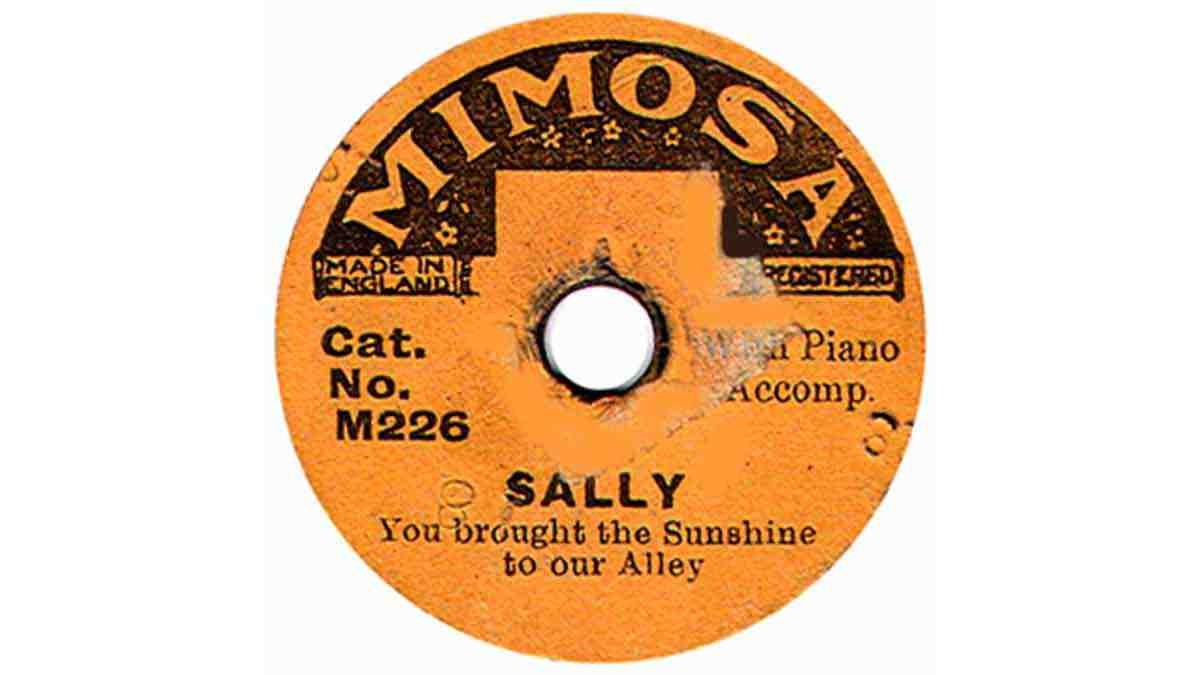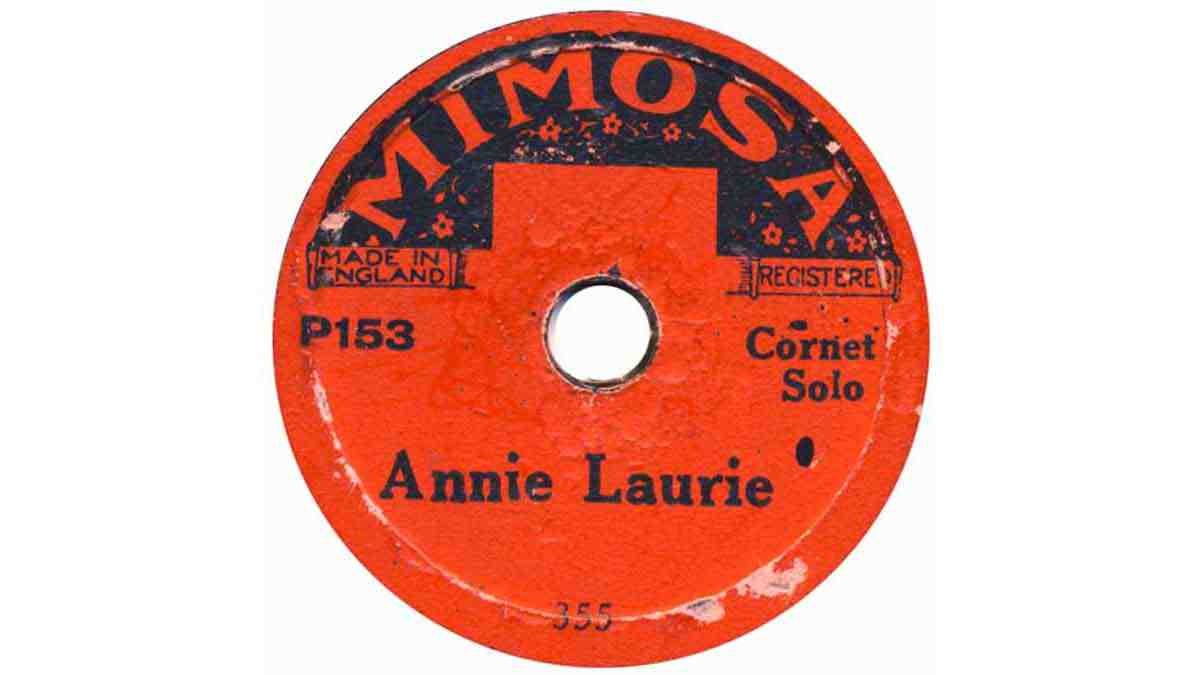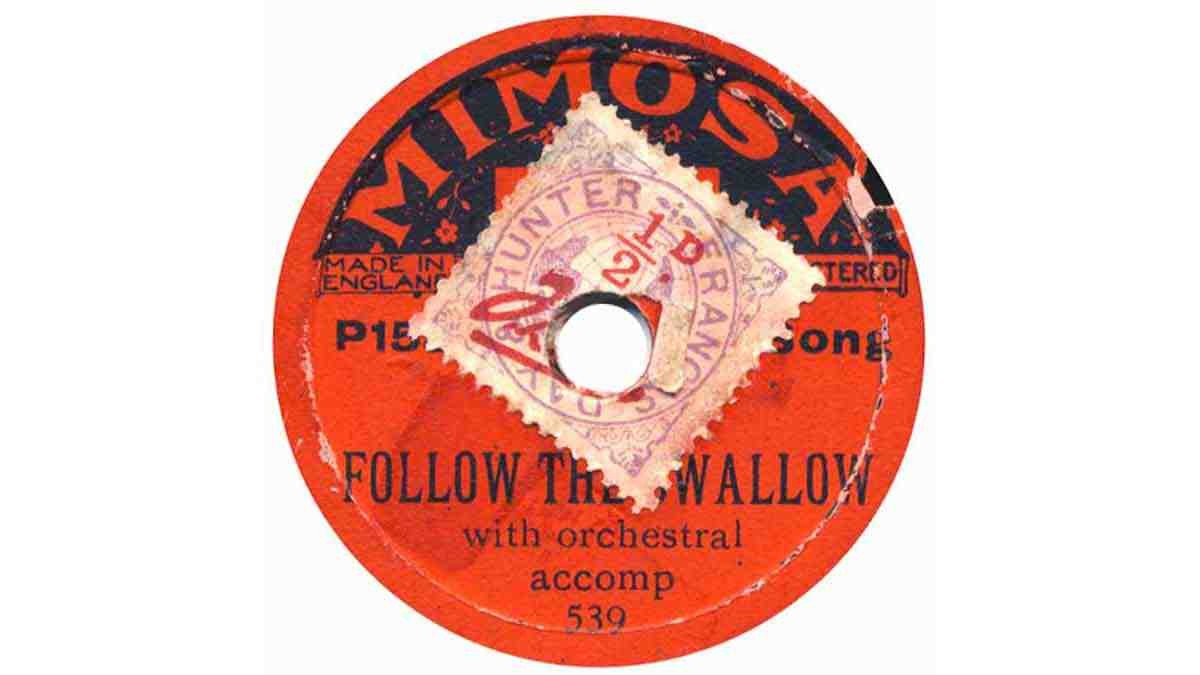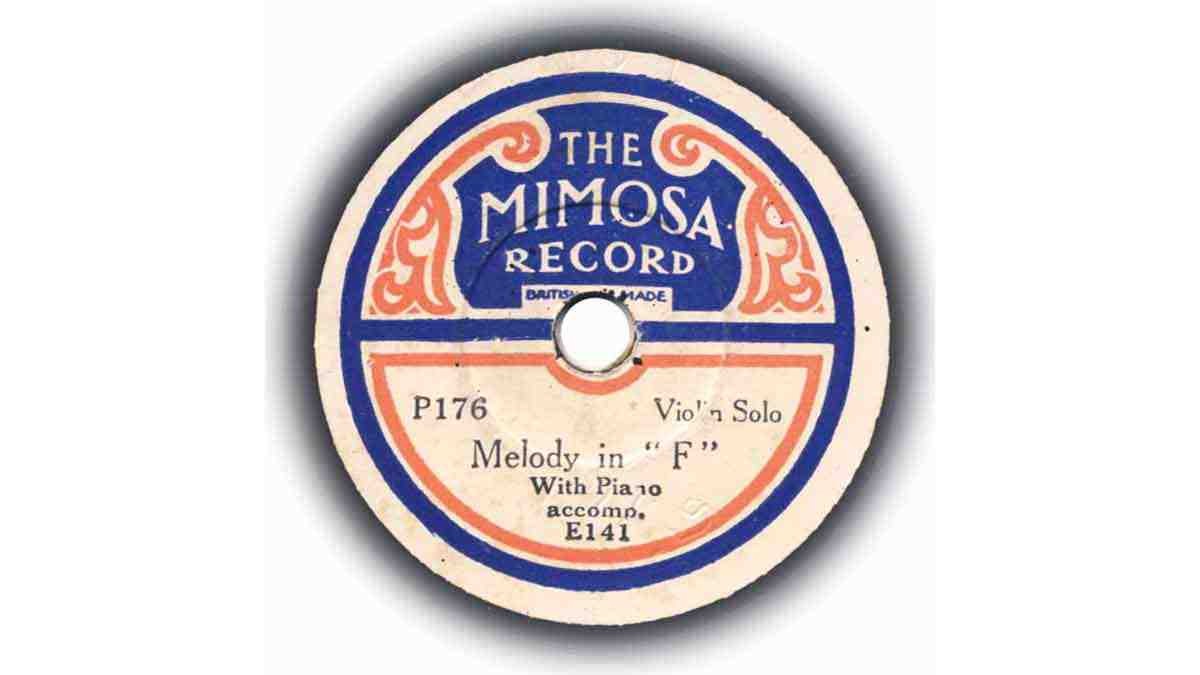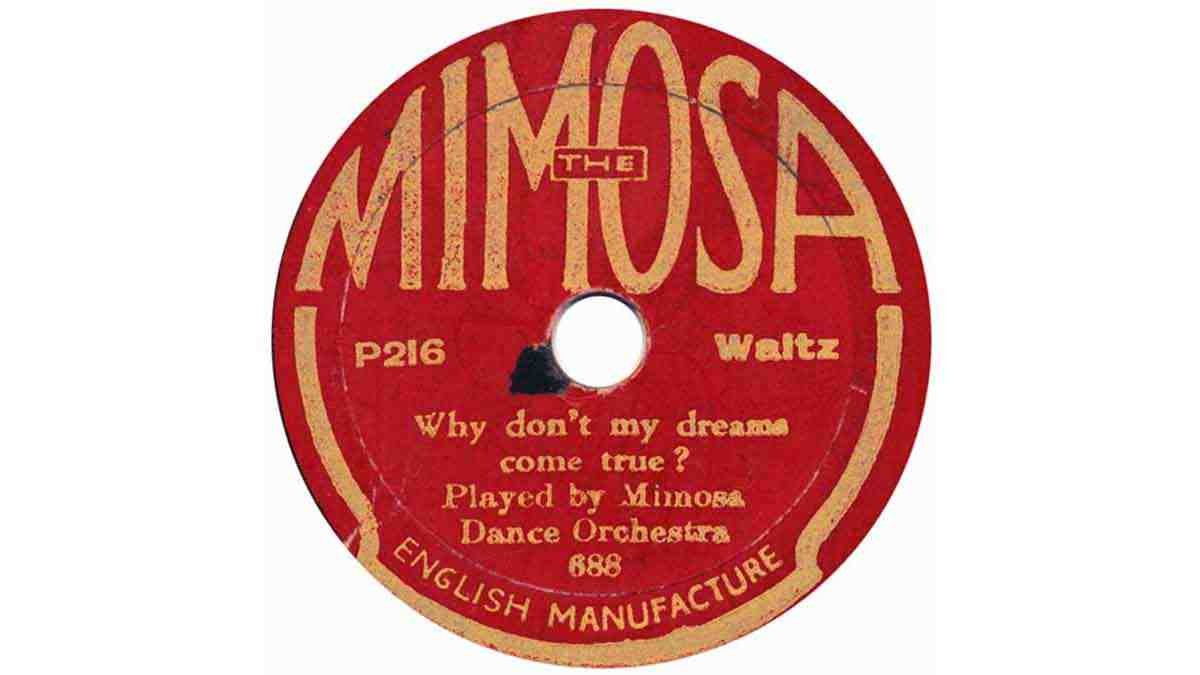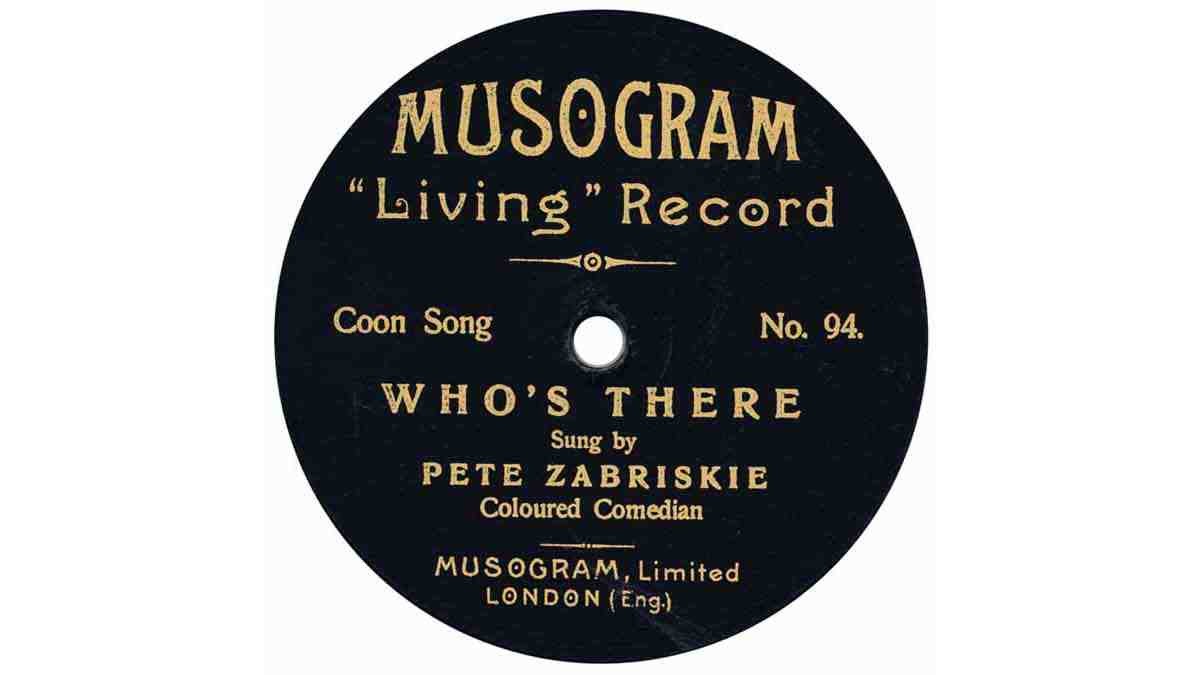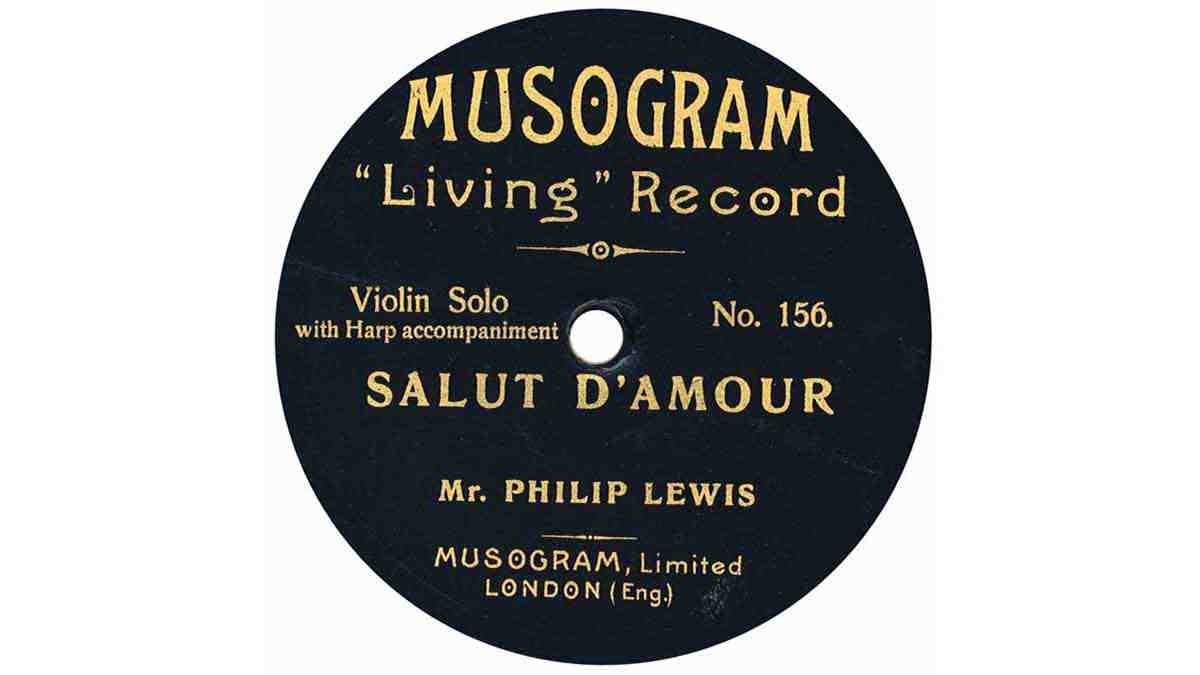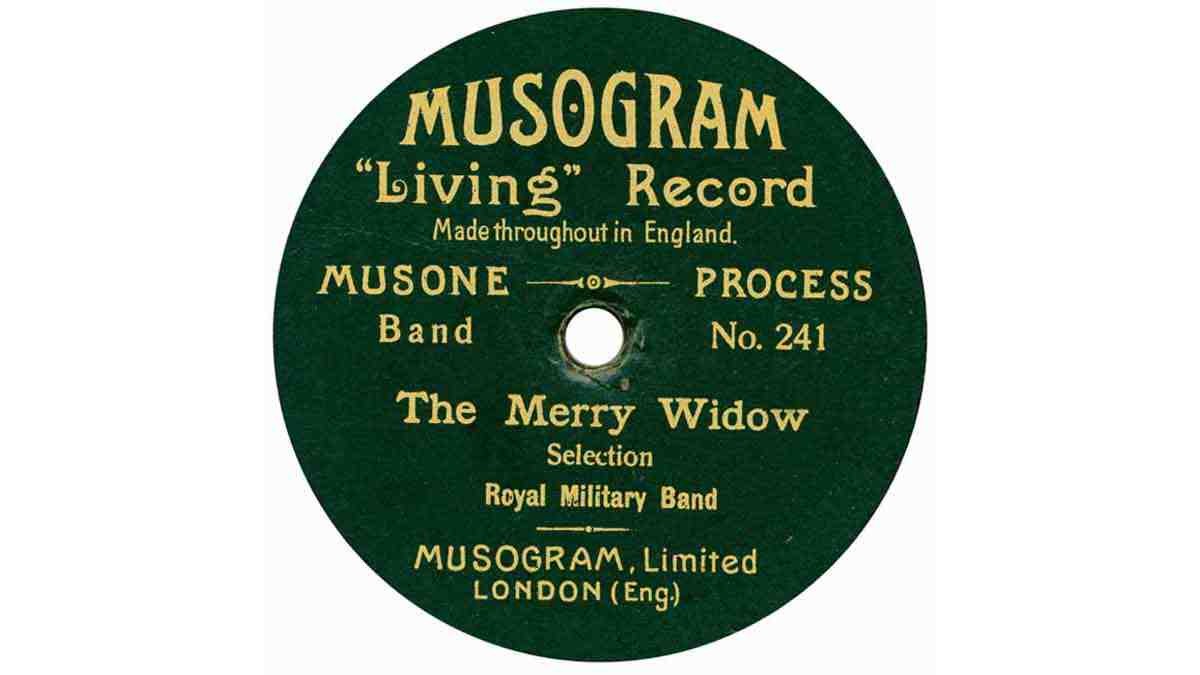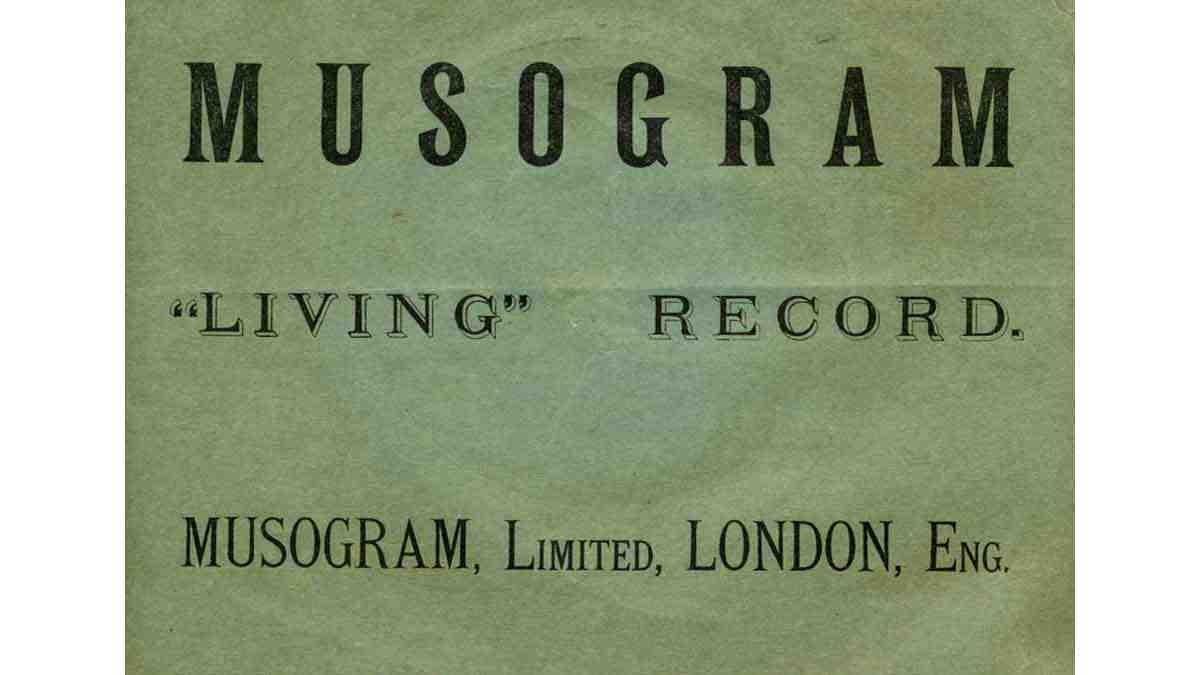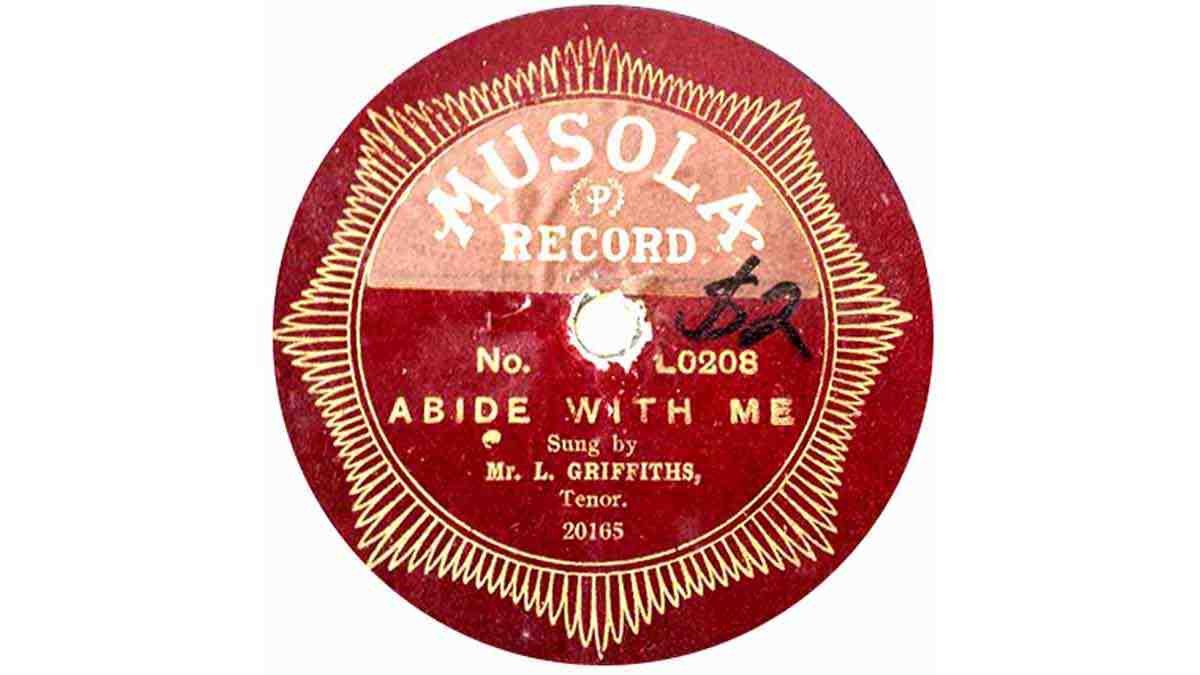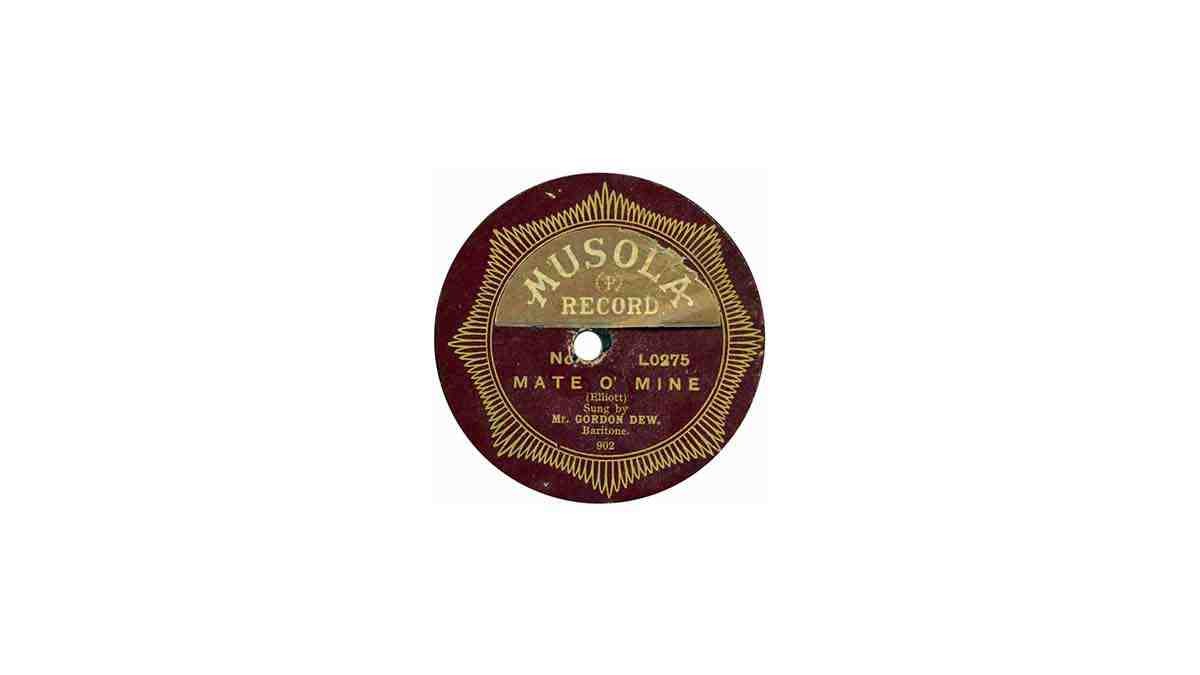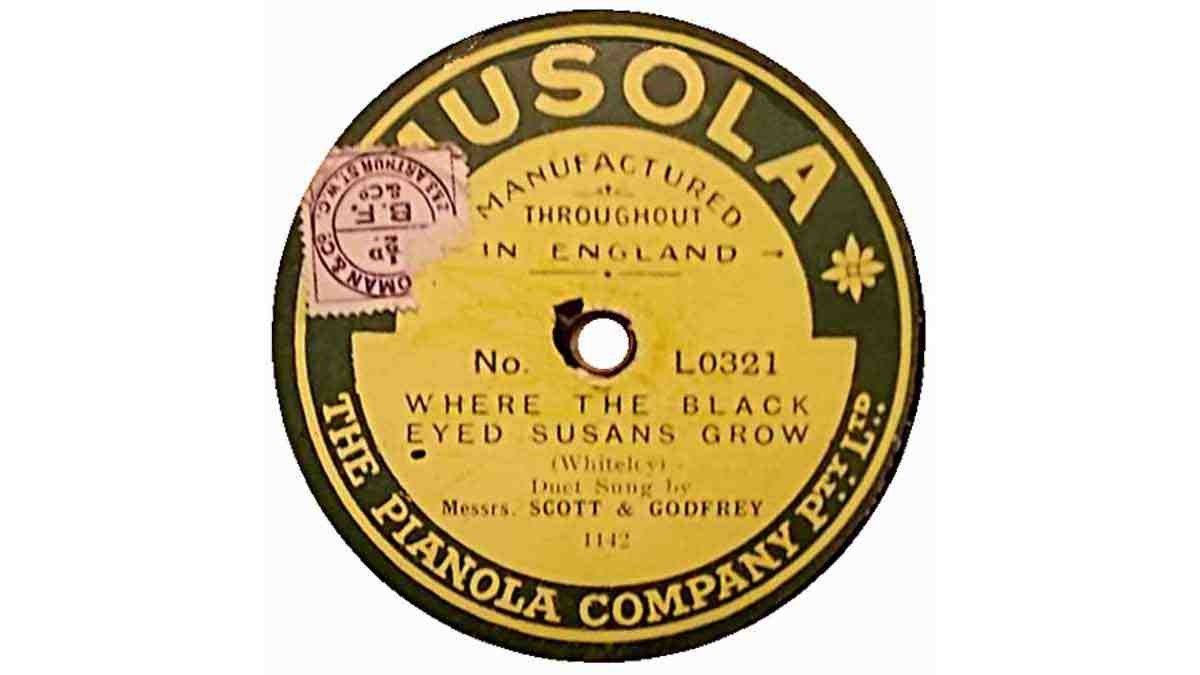
Marathon
See Frank Andrews, TMR 72, 1987; also FTR 19 2006-7. No less than 25 A4 pages of TMR 72 are devoted to Frank’s excellent history and summary of Marathon Records. The article is copiously illustrated by advertisements from rare trade journals, and an extensive listing of the records occupies 8 closely-typed pages. Everything one could ever wish to know about the National Gramophone Co., Ltd. who produced the label is there. There is also information on Musogram, a still rarer label. A ‘must read’. Marathon records were long-playing, small-groove vertical-cut discs. The ‘swatch’ under the label name was coloured differently depending on the type of repertoire. A pink swatch indicated a comic recording; dark blue denoted two or more voices; green was for instrumental and red was for solo voice. Their recording system, developed by Percy J Packman, was later ~1917) bought up by the U.S. Orchestrelle Co. when they decided to enter the record market. This was a singular distinction, for of course most early recording technology emanated from the U.S., not Europe. I am not quite certain where, or by whom, Marathon discs were actually pressed. They bear take symbols of the sort to be found on Edison Bell cylinders and discs, and this was initially thought to indicate that Marathons were pressed – or at least recorded – by ‘Edison Bell’. However, that may not be the case, because those symbols seem to have been devised by a recording engineer, C.R. Johnstone. He was originally with Edison Bell; but later left, with with two other defectors, to start a rival cylinder company. That company soon made Clarion discs, and these bear the ‘Johnstone’ symbols. (They are illustrated in our Clarion entry.) The same symbols also appearing on Marathon, with which Johnstone was certainly involved, may merely indicate it was he who made them at their ‘recording room’ in City Road, London. The record packets were unusual, being side-entry, like an LP. The company was inaugurated in August 1911. Marathon 388 was the longest-playing 10″ disc, at 5 minutes 28 seconds: Tom Kinniburgh singing ‘The Village Blacksmith’. 478 10″ and 66 12″ issues were produced by Marathon. The company failed in 1915. They are very seldom encountered; for while they were commendable, they stood too far apart in technology from the mainstream of disc records.
Marconi
See Frank Andrews, FTR 19. This was a U.S. label, single sided, and pressed into a thin layer of smooth compound, laminated over thin cardboard. It was, rather obviously, a collaboration between Guglielmo Marconi of wireless fame, and U.S. Columbia. An unbreakable record with a silent – or relatively silent – surface. Yes, even in 1907 the quest for such a disc was not new, and was to continue for many decades! They needed to be treated with some care, as the large back-sticker tells us. Moreover, they were very light; the one above weighs just 57 grams. Therefore they were prone to slipping on the turntable when a heavy sound box was placed on them. Accordingly, the back was pressed with a fine-pitch square pattern. Frank Andrews informs us that they were sold in this country – but not by the London branch of Columbia. Instead, they were offered by John Nottingham, ‘the doyen of talking machine dealers, trading as The American Talking Machine Company at 31, Tabernacle Street, London EC.’ Therefore they count as a British record. Though to judge from their scarcity, precious few people bought them…
Marspen
See Arthur Badrock, TMR 93, 1996; also Frank Andrews, HD 184, 1992. These were sold by Marks & Spencer’s chain stores. Beginning in 1921, these ~5.4″ (~13.75 cm) discs were made by two separate suppliers. Some came from J E Hough Ltd. (‘Edison Bell’), derived from Hough’s own masters which they were using on their ‘The Bell’ mini-discs. Others were pressed by Crystalate from Sound Recording Co. masters, which they used on their ‘Little Popular’ and ‘Mimosa’ discs. The first-mentioned were in a 600 series. They continued until at least 1926, when their size was increased to 6″ (15.25 cm).
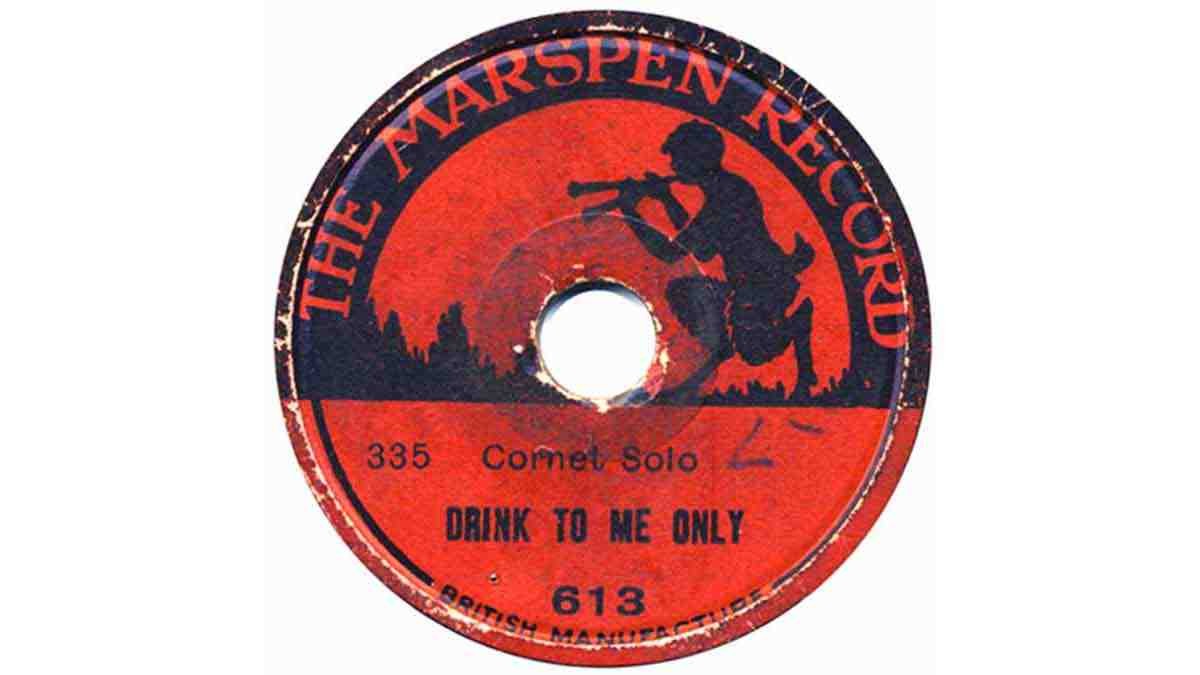
Melbaphone Record
See E78PB, Don Taylor. On p.141 of this superb (but now rather hard-to-find) book, we see an illustration of an ‘overstuck’ Edison Bell record, the new label bearing simply ‘Melbaphone Record’ in a simple design. The Artiste credit is type-written. At the time Don’s book was published, there was only one known example of the label. The label says: “Song. Some day I may forgive you. By Mr. R. Carr”, the Carr looking more liake Carn, but this is presumably the baritone Robert Carr, who recorded prolifically for practically every company between ~1900 and 1930, if not longer. The only problem is, I can’t find the tune by Carr on Winner. However: there is a version of the song on Edison Bell Velvet Face 1211, issued in January 1913, credited to ‘Fred Marshall – Comic’. Numbers in the wax of a Velvet Face & a Winner would certainly be indistinguishable by me; I’d have to look them up in the CLPGS Edison Bell Master listing, so just maybe the Melbaphone is stuck over a Velvet Face? If you wish you had an Excel database with just under 17,000 rows of data on all the different Edison Bell discs, you can get one! Just go to clpgs.org.uk then click ‘Shop’, then ‘Reference Series’ & go down to No.41…
Melody
See Frank Andrews: FTR 20, 2006-7. First advertised in September 1918, Melody Records were put out by Morgan & Scott, a religious publishing house. 12 issues were made in December 1918, numbered 251 – 262. Seven were 10″ and five were 12″, numbered indifferently. A few more ensued, but were not advertised in the trade papers. The songs, naturally published by Morgan & Scott, were recorded for them by the Invicta Record Company, whose principal label was of course Guardsman. Subsequently some of these M&S sides, possibly all, appeared on Guardsman too – perhaps 2 years later. E.g. ‘There Is Never A Day So Dreary’ is on Guardsman 1048.
Melograph
See Frank Andrews: FTR 22, 2007. In this article, Frank tells us that the Melograph Disc Record Co. Ltd. was based in Liverpool. It began trading in August 1907. Its discs were manufactured by Hess & Co. of Berlin, whose label was ‘Star Records’, and from which the early masters were derived. Frank illustrates a Melograph disc, with a beautiful coloured design (very Germanic) which was apparently a trade mark applied for in 1907. Frank has found no information as to it being granted. Perhaps this disc was one of a pilot batch? By January 1908 Melograph had their own recording room in Liverpool. They were also inviting stockists (to whom they sold their discs directly, not via a wholesaler) to recommend local ‘talent’, who could be recorded in Liverpool, the resulting discs to be sold in the region of the dealer. Though not without precedent, ‘regional’ record labels were fairly unusual for such a small country as the UK. Frank informs us that certain vocal records issued in March 1911 carried little-known names. Ordinarily, these would just have been pseudonyms; but in view of Melograph’s policy, they may well be by provincial artistes. Certainly one of them, Arthur Frame, was indeed a Liverpool singer. The company never seems to have really prospered; Melograph discs are seldom seen. Nevertheless, Frank knows a span of 127 10″ and twelve 12″ issues, though few are documented. The outbreak of war in August 1914 cut off supplies from Berlin, and the company soon foundered. The green label forms on the right are a scarce later variant.
Meloto
See Frank Andrews: FTR 7, 2003. Meloto records appeared in 1922. They were pressed by The Aeolian Company, from the masters variously available to that concern. Those included Gennett (‘Oh By Jingo’ above), their own Aco (‘The Musical Box’) and Guardsman (‘Indian Love Lyrics’). This last-named was originally on Guardsman 2071, with master 1299-X. Under the label of it may be seen ‘P J P’ written in the wax in a neat hand. This can only be Percy J Packman, the inventor and recording expert. We have never seen PJP under any Guardsman labels, and wonder what it might mean. But I digress. Melotos were seemingly never sold in normal retail outlets, but by the ‘tallyman’ system. Frank states: “On purchasing an initial dozen Meloto discs, and signing a contract to purchase eight discs a month for the next 23 months, a customer was presented with a walnut-cased gramophone, which became the customer’s own property upon completion of the contract”. This is a similar arrangement to that employed before the Great War by the John Bull concern. It was, however, more ambitious (and onerous to the contractee) in stretching over a period of 2 years instead of one, and requiring the purchase of 8 discs a month rather than four, as with John Bull! The comparative scarcity of Meloto records (though a great many seem to have been issued) suggest the small scale on which the company operated; though it was active for a number of years, possibly up to 1927, for electrically-recorded Melotos are known.
Menzenhauer Concert
Dr. Lotz has kindly sent us another German label with the titles in several languages. It was manufactured by the Kalliope company, who were based in Dresden. They were obviously made so that a factor or wholesaler could – or might – sell them in different countries. There are quite a few of these multi-lingual discs. There is currently little evidence that many of them appeared here, but all are included in these pages to be on the safe side!
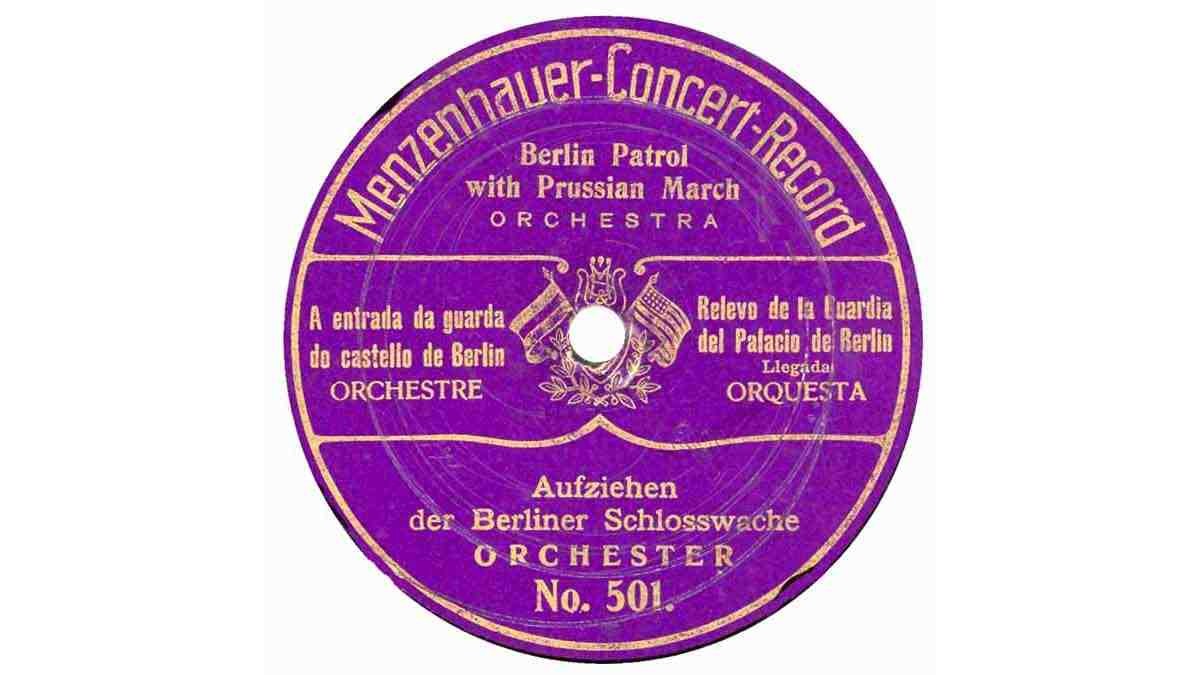
Metropol
See Frank Andrews, FTR 23, 2007. In January 1913, Berolina Schallplatten GmbH of Berlin applied for a British trade mark ‘Metropol’. But Frank does not think that any Metropol records were ever marketed here, and included the mark in his articles for completeness’ sake.
Mignon
See Frank Andrews, FTR 23, 2007. These 6″ (15.25 cm) double sided discs first appeared in late 1912 as part of a Gramophone Outfit. Retailing for £1, you got a little gramophone, plus an album of 6 discs, a box of needles & a carrying case. The Beka Company (a ‘subsidiary’ of Carl Lindström AG) made them, and they carry the same legend as 10″ Bekas: ‘Recorded in London – Reproduced in Prussia’. The catalogue numbers began at 1, and Frank thinks that three separate albums were issued, as Mignon 14 has been reported. How long they lasted is not known; also, they are scarce.
Millophone
See NR; also Frank Andrews: FTR 23, 2007. The first two incarnations of Millophone are exceptionally scarce and we are very grateful to Philip Gordon-Booth and Mike Jones for sending images of these. The proprietor was one H Mill, principal of ‘The Bancroftian Company’. The first series appeared in October 1908, ready for the Christmas season. They were pressed from masters of the Nicole concern, which had folded in 1906. Its metalwork had passed to the Disc Record Company of Stockport, Lancs., who produced them for Mill. The series ran from 1001 to 1139, but sales can only have been minuscule. The green hand-written label is either another series of unknown length and origin, or perhaps No. 1004 from the Nicole source, overstuck for some reason? We shall probably never know. Happily, Frank’s article in FTR tells us that later Millophones are more straightforward. They were manufactured by ‘Edison Bell’, using masters from its Bell Disc label, which were 10.25″ diameter, and later 10″ dia. from the Winner series. They appeared in October 1909, and no catalogue numbers are known to Frank lower than 140, or higher than 386 – though as you see, we can now extend that range to 394. The red Millophone New “Celebrity” Record was also made by Edison Bell, but from masters from its Velvet Face label, which carried more exalted repertoire. It looks as though the catalogue numbers of these started at 1. They also began as 10.25″ size, which duly shrank to 10″ when Edison Bell reduced the size on its own discs. A 12″ series of Millophone existed around July 1913. It is not known when these later Millophones ceased to appear.
Mimosa
See Frank Andrews, HD 162, 1988. Mimosa records first appeared in 1921 in single-sided format and ~5.4″ (13.75 cm) diameter. They were a product of the Sound Recording Company and as usual, were pressed by Crystalate in or near Tonbridge in Kent. The earliest ones were laminated onto a cardboard core, but later normal shellac was used. They were sold in Woolworth’s stores at 6d (2.5p) each. They had an M- prefix to begin with, changing in October 1921 to P. Later they were double sided. All the above are double-sided except the first one. The apparently fluctuating size is presumably due to remakes? Note how the copyright stamp swamps the label. Later, miniature stamp designs (indicia) were printed on the label of many smaller discs.
Minstrel
See a short history and listing of these. There are two series. One (as above) was made in the U.K. by ‘Edison Bell’, drawing on early masters from its Winner label – and also possibly their Velvet Face marque. Numbers ran from 1 to at least 60. They were made for J.E. Pidgeon Ltd. of Christchurch, New Zealand. Pidgeon was a wholesaler, also offering gramophones, though the website above tells us that none have yet been seen in New Zealand; indeed, Minstrel Records are themselves scarce. There was a second series of discs, running from 2001 to at least 2020, all of which were by the comedian Billy Williams. These were derived from Favorite masters recorded in the U.K., though they would have been pressed in Germany – hence the (slightly different) label states: ‘Pressed Abroad’, and bears at the foot the tell-tale Favorite face number, encoded using punctuation marks. E.g. : ( > | Λ / = 67183 = Billy Williams from British Favorite 332, issued in September 1911. Minstrel records would date from ca. 1912-1914 – possibly a little later. See also Pidgeon’s other label, Herald. Wholesalers often had more than one label; some had several. We conjecture that this enabled them to supply two (or more) retailers in the same town without introducing unwanted rivalry between them.
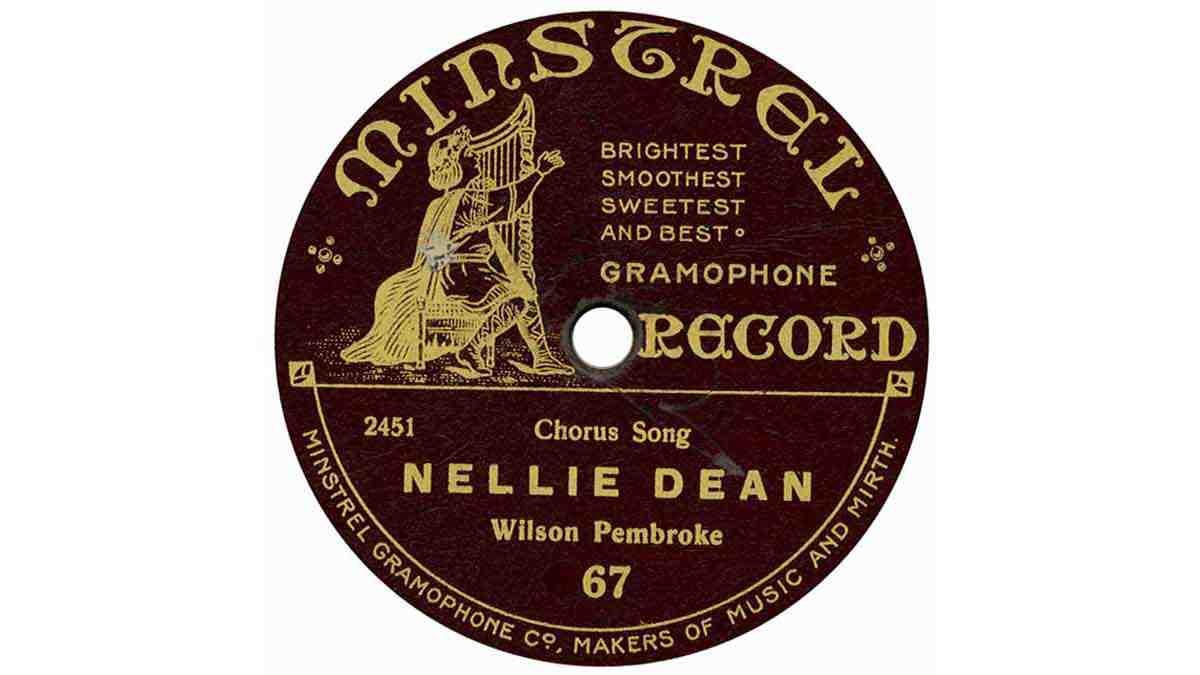
Musogram
See Frank Andrews: FTR 24, 2007-8; also TMR 72, 1987. No attempt is made here to paraphrase Frank’s long and fascinating article on this obscure and short-lived label. Suffice it to say that the discs appeared in December 1909, and the third and final issue was made just 6 months later in May 1910. The discs were vertically cut with a ‘U’ profile, the invention of Percy J. Packman. The black label discs have a standard grove pitch and so play for about 3.5 minutes. The green label ‘Musone Process’ discs had a finer groove Both 10.5″ and 12″ sizes were produced, and one 12″ ‘Musone’ disc here plays for nearly 8 minutes at the prescribed speed of 75 rpm. Several of the people involved with Musogram had previously been with Neophone. (In turn, it may be that after the failure of Musogram, some of those very people became connected with The Sound Recording Company, whose label was called Grammavox. Evidence? The label design is rather similar, and the unusual abbreviation: ‘London (Eng.)’ is common to both.) Part of a Musogram packet is illustrated. There was no hole to view the label. Musograms are extremely scarce.
Musola 1
See Frank Andrews, HD 116; FTR 24, 2007-8. The trade mark ‘Musola’ was registered to the Orchestrelle Co., probably in late 1916 or early 1917. Musola records were pressed, by Crystalate, from existing Guardsman masters. L0208 was on Guardsman 234 credited to Thomas Jackson, and L0275 was Guardsman 696 as Wesley Baker. All four names are likely to be pseudonyms. In any case, the sales of these ‘starburst’ label discs in the UK must have been microscopic; they are almost never seen. Frank Andrews say a large batch (about 300 issues) were sent as one big shipment to Australia, as the label above, kindly sent by Ern Taylor, attests. Still, there can only have been a few copies of each the 300 discs, as Ern confirms that Musola is very scarce in Austalia. The material issued on Musola dates from 1912 – 1917, but the availability of the discs was around 1917 – 1919. The off-centre label in the second image above shows the slipshod production methods that often prevailed at Crystalate around that time. One is tempted to conjecture that Musola, Neptune and other such labels were very much ‘made down to a price’, so that little care was taken in their production? See also Phoneto.
Musola 2
See Frank Andrews, FTR 24, 2007-8. This post-Great War Dutch label is included on the grounds that it is known to carry some London recordings made by Homophone, dating as far back as 1909. Frank does not know the connection between the Dutch and British Musola Companies, though there clearly was one. The Dutch disc above is provisionally dated to circa 1922-23.
